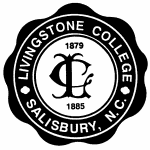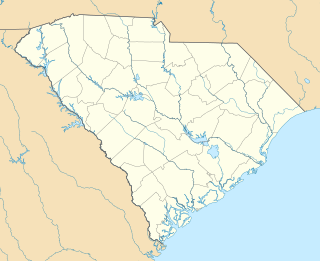
Burlington is a city in Alamance and Guilford counties in the U.S. state of North Carolina. It is the principal city of the Burlington, North Carolina Metropolitan Statistical Area, which encompasses all of Alamance County, in which most of the city is located, and is a part of the Greensboro-Winston-Salem-High Point CSA. The population was 50,042 at the 2010 census, which makes Burlington the 17th largest city in North Carolina. The Metropolitan Statistical Area population was over 150,000 in 2010.

Elon University is a private university in Elon, North Carolina. Founded in 1889 as Elon College, Elon is organized into six schools, most of which offer bachelor's degrees and several of which offer master's degrees or professional doctorate degrees.

Livingstone College is a private, historically black Christian college in Salisbury, North Carolina. It is affiliated with the African Methodist Episcopal Zion Church. Livingstone College is accredited by the Commission on Colleges of the Southern Association of Colleges and Schools to award the Bachelor of Arts, Bachelor of Science, Bachelor of Fine Arts, and Bachelor of Social Work degrees.

The Cedarock Historical Farm, located at Cedarock Park in Alamance County, North Carolina, provides an example of life on a farm in North Carolina during the 19th Century. Populated with farm animals, antique and replica farm equipment, and a farmhouse, the Historical Farm provides a fun, education stop while visiting Cedarock Park.

Saint Mary's School is a private independent Episcopal college-preparatory, boarding and day school for girls in grades 9–12. Located in Raleigh, North Carolina, Saint Mary's School operates as an independent school with a historic association with the Episcopal Church including an Episcopal chapel, St. Mary's Chapel, on the school's grounds. The school formerly operated as Saint Mary's College and for many decades educated young women in grades 11–12 and their freshman and sophomore years in college. The school changed to a four year high school in 1998, at which point the name reverted to Saint Mary's School, the original name of the institution when it was founded in 1842.

This list includes properties and districts listed on the National Register of Historic Places in Alamance County, North Carolina. Click the "Map of all coordinates" link to the right to view an online map of all properties and districts with latitude and longitude coordinates in the table below.

Johnston Hall is a historic building located on the campus of Elon University in Elon, Alamance County, North Carolina. It was built in 1925, and is a substantial, two-story, "H"-shaped, red brick Classical Revival style building. The front facade features a one-story flat-foof porch carried by brick piers. The building is the historical centerpiece of the Elon Homes for Children campus, an orphanage founded in 1907. The building is named for Charles David Johnston, superintendent of the orphanage.

Spring Friends Meeting House is a historic Quaker meeting house located at Snow Camp, Alamance County, North Carolina. The fourth and current meeting house was built in 1907, and is a small rectangular frame one-story gable-front building. It features Gothic Revival style lancet windows and a short, plain rectangular cupola with pyramidal roof. Spring Friends Meeting is an active congregation of Quakers from the Alamance, Chatham, Orange, Guilford and Randolph County area of North Carolina. Members of the Religious Society of Friends first started "meeting at the spring" around 1761, with the congregation formally recognized by North Carolina Yearly Meeting in 1773. The adjacent contributing cemetery dates from the founding of the meeting, about 1761. It contains the graves of some of the earliest Quaker settlers in Alamance County, as well as the unmarked graves of approximately 25 American Revolutionary War soldiers killed in the 1781 Battle of Lindley's Mill. The battle itself was waged around the meeting house, with governor Thomas Burke and other officials held prisoner in the original meeting house during the battle.

North Dakota State University District is a 36-acre (15 ha) historic district on the campus of North Dakota State University, in Fargo, North Dakota, that was listed on the National Register of Historic Places in 1986.

South Carolina State College Historic District is a national historic district located on the campus of South Carolina State University at Orangeburg, Orangeburg County, South Carolina. The district encompasses 10 contributing buildings, 1 contributing site, and 1 contributing object at the core of the historically black university. They were constructed between 1917 and 1950, and include a variety of architectural styles including Classical Revival and International Style. Notable buildings include the separately listed Hodge Hall and Lowman Hall, along with Home Management House, Mechanical Industries Hall, and Wilkinson Hall. Also on the campus, but located outside the district, is Dukes Gymnasium.

West Davis Street–Fountain Place Historic District is a national historic district located at Burlington, Alamance County, North Carolina. It encompasses 138 contributing buildings in a primarily middle-class residential section of Burlington. Most of the dwellings date to the late-19th and early-20th century and include representative examples of Queen Anne and Colonial Revival style architecture.

East Davis Street Historic District is a national historic district located at Burlington, Alamance County, North Carolina. It encompasses 43 contributing buildings in a primarily residential section of Burlington. It includes single and multi-family dwellings, one commercial building and one church that were predominantly constructed from the 1880s to 1950. The buildings include representative examples of Queen Anne and Classical Revival style architecture.

South Broad–East Fifth Streets Historic District is a national historic district in Burlington, Alamance County, North Carolina. It encompasses 108 contributing buildings in a primarily residential section of Burlington. Most of the buildings are houses, one to two stories high, built between the 1890s and the 1940s in late Victorian, Queen Anne, American Craftsman, and Colonial Revival styles of frame or brick construction.

Beverly Hills Historic District is a national historic district located at Burlington, Alamance County, North Carolina. It encompasses 108 contributing buildings, 3 contributing structures, and 2 contributing objects in a planned residential subdivision of Burlington. Most of the buildings are houses, one to two stories high, built between about 1919 and 1959 in I-house, Tudor Revival, American Craftsman, Colonial Revival, and Mediterranean Revival styles of frame or brick construction.

Alamance Mill Village Historic District is a national historic district located at Alamance, Alamance County, North Carolina. It encompasses 18 contributing buildings and 1 contributing structure built between 1840 and 1947 in Alamance. The district includes 15 mill houses, a warehouse, and the mill dam and connected remains of the head race.

North Main Street Historic District is a national historic district located at Graham, Alamance County, North Carolina. It encompasses 72 contributing buildings and 1 contributing structure in the central business district of Graham. The district includes a variety of institutional, commercial, and residential buildings largely dating from the 19th century. Notable buildings include the Alamance County Courthouse, the centerpiece of the district; Graham Presbyterian Church; Harden House; Hunter House; Nicks Store; McBride Holt House ; Scott Building ; Vestal Hotel; Holt-Scott General·Store ; National Bank of Alamance ; Mont-White Theatre; and Paris Building.

Henderson Scott Farm Historic District is a historic farm and national historic district located near Mebane, Alamance County, North Carolina. It encompasses 10 contributing buildings on a farm near Mebane. The district includes the Federal style First Henderson Scott House (1836), Greek Revival style Second Henderson Scott House (1849), smokehouse, garage (1918), milk/butter House, Henderson Scott Store (1855), sheep barn, dairy barn 1, chicken house, and wellhouse.

Mebane Commercial Historic District is a national historic district located at Mebane, Alamance County, North Carolina. It encompasses 30 contributing buildings, and 1 contributing structure in the central business district of Mebane. The district includes one and two-part commercial blocks of one to three stories in height, executed in the Colonial Revival and Neo-Classical styles. The earliest buildings date to about 1905. Notable buildings include two former banks, the Five Star Building, Mebane Enterprise Building, and Jones Department Store Building.

Davidson Historic District is a national historic district located at Davidson, Mecklenburg County, North Carolina. The district encompasses 394 contributing buildings, 2 contributing sites, and 2 contributing structures in the central business district and surrounding residential neighborhoods of Davidson and campus of Davidson College. It was developed after 1837 and includes notable examples of Italianate, Greek Revival, and Gothic Revival style architecture. Located in the district are the separately listed Eumenean Hall and Philanthropic Hall. Other notable buildings include the Maxwell Chambers Building, Jackson Row (1928), Helper Hotel (1848), Johnston Grocery Store (1912), Southern Railway Depot (1897), Linden Cotton Factory (1890), Delburg Cotton Mills (1908), Davidson United Methodist Church (1908), Davidson College Presbyterian Church (1951), and Carnegie Library (1909).

Chapel Hill Historic District is a national historic district located at Chapel Hill, Orange County, North Carolina. The district encompasses 46 contributing buildings, 2 contributing structures, and 2 contributing objects on the central campus of the University of North Carolina at Chapel Hill and surrounding residential sections of Chapel Hill. The district's buildings date from 1795 to the early-20th century and include notable examples of Classical Revival and Jacobean Revival architecture. Located in the district and separately listed are the Chapel of the Cross, Old East, building and Playmakers Theatre. Other notable contributing resources are the Davie Poplar, Old West (1822), South Building (1798), the Old Well, Person Hall (1797), Gerrard Hall (1822), New East, New West, the Joseph Caldwell Monument (1858), the Y.M.C.A. Building, Battle-Vance-Pettigre11 Dormitory (1913), Horace Williams House (1854), the Phillips Law Office, the Phillips House (1856), the Old Methodist Church (1853), Senlac, Hippol Castle (1920s), and Battle Park.






















